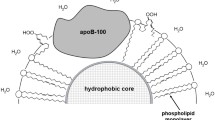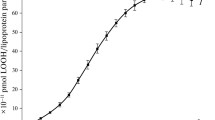Abstract
We have recently demonstrated that lipids, particularly cholesterol, covalently bound to apolipoprotein B (apoB) are a stable marker of low density lipoprotein (LDL) oxidation (Tertov et al. 1995). The present study is an attempt to assess the relationship between the degree of LDL oxidation, evaluated by the content of apoB-bound cholesterol and the ability of LDL to induce cholesterol accumulation in cultured human aortic intimal smooth muscle cells, i.e. LDL atherogenicity. Native LDL was oxidized in vitro by copper ions, 2,2-azobis-(2-aminopropane hydrochloride), or sodium hypochlorite. Minimum degree of LDL in vitro oxidation necessary to convert LDL into atherogenic one was accompanied by an increase of apoB-bound cholesterol to the level much higher than that usually observed in freshly isolated atherogenic LDL from human blood. Moreover, elimination of LDL aggregates from in vitro oxidized LDL preparations by gel filtration led to loss of its atherogenic properties. Thus, the ability to induce cholesterol accumulation in cells, i.e. the atherogenicity of in vitro oxidized LDL is a result of LDL aggregation but not oxidation. We also studied the relationship between LDL atherogenicity and apoB-bound cholesterol content in LDL freshly isolated from healthy subjects and normo- and hypercholesterolemic patients with coronary atherosclerosis. The ability of human LDL to induce cholesterol accumulation in aortic smooth muscle cells did not correlate with the degree of in vivo LDL oxidation (r = 0.12, n = 90). It is concluded that LDL atherogenicity does not depend on the degree of lipid peroxidation in LDL particle.
Similar content being viewed by others
References
Nishida EG, Kummerow FA: Interaction of serum lipoproteins with the hydroperoxide of methyllinoleate. J Lipid Res 1: 450–458, 1960
Clark DA, Foulds EL, Jr, Wilson FH, Jr: Effects of hydrogen peroxide on lipoproteins and associated lipids. Lipids 4: 1–8, 1969
Bermes Jr EW, McDonald HJ: The stability of human serum lipoprotein in vitro. Ann Clin Lab Sci 2: 226–232, 1972
Schuh J, Fairclough GF, Haschemeyer RH: Oxygen-mediated heterogeneity of apo-low density lipoprotein. Proc Natl Acad Sci USA 75: 3173–3177, 1978
Steinberg D, Parthasarathy S, Carew TE, Khoo J, Witztum J: Beyond cholesterol: Modifications of low density lipoprotein that increase its atherogenicity. N Engl J Med 320: 915–924, 1989
Tertov VV, Kaplun VV, Dvoryantsev SN, Orekhov AN: Apolipoprotein B-bound lipids as a marker for evaluation of low density lipoprotein oxidation in vivo. Biochem Biophys Res Commun 214: 608–613, 1995
Orekhov AN, Tertov VV, Kudryashov SA, Smirnov VN: Triggerlike stimulation of cholesterol accumulation and DNA and extracellular matrix synthesis induced by atherogenic serum or low density lipoprotein in cultured cells. Circ Res 66: 311–320, 1990
Tertov VV, Sobenin IA, Gabbasov ZA, Popov EG, Yaroslavov AA, Smirnov VN, Orekhov AN: Three types of naturally occuring modified lipoproteins induce intracellular lipid accumulation due to lipoprotein aggregation. Circ Res 71: 218–228, 1992
Lowry OH, Rosenbrough NJ, Farr AL, Randall RJ: Protein measurement with the Folin phenol reagent. J Biol Chem 193: 265–275, 1953
Orekhov AN, Tertov VV, Novikov, ID, Krushinsky AV, Andreeva ER, Lankin VZ, Smirnov VN: Lipids in cells of atherosclerotic and uninvolved human aorta. I. Lipid composition of aortic tissue and enzyme isolated and cultured cells. Exp Mol Pathol. 42: 117–137, 1985
Tertov VV, Sobenin IA, Gabbasov ZA, Popov EG, Jaakkola O, Solakivi T, Nikkari T, Smirnov VN, Orekhov AN: Multiple-modified desialylated low density lipoproteins that cause intracellular lipid accumulation: Isolation, fractionation and characterization. Lab Invest 67: 665–675, 1992
Hara A, Radin NS: Lipid extraction of tissue with low-toxicity solvent. Anal Biochem 90: 420–426, 1978
Yagi K: Lipid peroxidation. Assay for blood plasma and serum. Methods Enzymol 105: 328–333, 1984
Balla G, Jacob JW, Eaton JD, Belcher JD, Verchellotti GM: Hemin: A possible physiological mediator of low density lipoprotein oxidation and endothelial injury. Arterioscler Thromb 11: 1700–1711, 1991
Esterbauer H, Striegl G, Puhl H, Rotheneder M: Continuous monitoring of in vitro oxidation of human low density lipoprotein. Free Radical Res Commun 6: 65–75, 1989
Dixon WJ, Brown MB. Biomedical Computer Programs. P-Series, Berkeley, CA: University California Press, 1979, pp 185–198.
Afifi AA, Azen SP. Statistical analysis. A computer oriented approach, New York: Academic Press, 1979, pp 138–142
Orekhov AN, Tertov VV, Pokrovsky SN, Adamova IYu, Martsenyuk ON, Lyakishev AA, Smirnov VN: Blood serum atherogenicity associated with coronary atherosclerosis. Evidence for non-lipid factor providing atherogenicity of low-density lipoproteins and an approach to its elimination. Circ Res 62: 421–429, 1988
Tertov VV, Orekhov AN, Martsenyuk ON, Perova NV, Smirnov VN: Low density lipoproteins isolated from the blood of patients with coronary heart disease induce the accumulation of lipids in human aortic cells. Exp Mol Pathol 50: 337–347, 1989
Tertov VV, Sobenin IA, Gabbasov ZA, Popov EG, Orekhov AN: Lipoprotein aggregation as an essential condition of intracellular lipid caused by modified low density lipoproteins. Biochem Biophys Res Commun 163: 489–494, 1989
Hoff HF, O'Neil J: Lesion-derived low density lipoprotein and oxidized low density lipoprotein share a lability for aggregation, leading to enhanced macrophage degradation. Arterioscler. Thromb 11: 1209–1222, 1991
Hazel LJ, Stocker R: Oxidation of low-density lipoprotein with hypochlorite causes aggregation that is mediated by modification of Iysine residues rather than lipid oxidation. Biochem J 302: 165–172, 1994
Kawabe Y, Cynshi O, Takashima Y, Suzuki T, Ohba Y, Kodama T: Oxidation induced aggregation of rabbit low-density lipoprotein by azo initiator. Arch Biochem Biophys 310: 489–496, 1994
Maebe R, Shimasaki H, Ueta N: Conformational changes in oxidized LDL recognized by mouse peritonel macrophages. Biochim Biophys Acta 1215: 79–86, 1994
Orekhov AN, Tertov VV, Mukhin DN, Mikhailenko IA: Modification of low density lipoprotein by desialylation causes lipid accumulation in cultured cells. Discovery of desialylated lipoprotein with altered cellular metabolism in the blood of atherosclerotic patients. Biochem Biophys Res Commun 162: 206–211, 1989
Orekhov AN, Tertov VV, Sobenin IA, Smirnov VN, Via DP, Guevara J, Gotto AM Jr, Morrisett JD: Sialic acid content of human low density lipoproteins affects their interaction with cell receptors and intracellular lipid accumulation. J Lipid Res 33: 805–817, 1992
Avogaro P, Bittolo Bon G, Cazzolato G: Presence of a modified low density lipoprotein in humans. Arteriosclerosis 8: 79–87, 1988
Jaakkola O, Solakivi T, Tertov VV, Orekhov AN, Miettinen TA, Nikkari T: Characteristics of low-density lipoprotein subfractions from patients with coronary artery disease. Coron Artery Dis 4: 379–385, 1993
Karmansky IM, Kovaleva GG, Viktorova LN, Shpikiter VO: Influence of serum low density lipoprotein proteolysis on their interaction with macrophages. Bull Exp Biol Med 102: 148–151, 1986
Kokkonen JO, Kovanen PT: Proteolytic enzymes of mast cells granules degrade low density lipoprotein and promote their granule-mediated uptake by macrophages in vitro. J Biol Chem 264: 10749–10755, 1989
Suits AG, Chait A, Aviram M, Heinecke JW: Phagocytosis of aggregated lipoprotein by macrophages: Low density lipoprotein receptor-dependent foam-cell formation. Proc Natl Acad Sci USA 86: 2713–2717, 1989
Author information
Authors and Affiliations
Rights and permissions
About this article
Cite this article
Tertov, V.V., Kaplun, V.V. & Orekhov, A.N. In vivo oxidized low desinty lipoprotein: Degree of lipoprotein oxidation does not correlate with its atherogenic properties. Mol Cell Biochem 183, 141–146 (1998). https://doi.org/10.1023/A:1006811720282
Issue Date:
DOI: https://doi.org/10.1023/A:1006811720282




